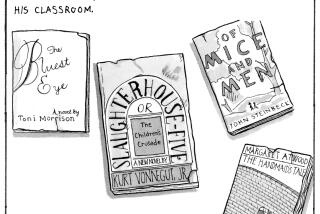‘Big Nate’ books rise in popularity, with a comic twist
If there’s a common thread among bestselling books for elementary school boys, it’s the merry mischief maker traipsing through a comics-laden landscape. It is now a common literary trajectory that boys begin their independent reading lives following Dav Pilkey’s prankster duo in the “Captain Underpants” series before moving on to Jeff Kinney’s “Diary of a Wimpy Kid” books and the more recent phenom, “Big Nate,” from author and illustrator Lincoln Peirce.
Peirce isn’t as well known as Pilkey or Kinney, though all three authors are in their 40s. Peirce has racked up 4 million sales since his first book was published in 2009, but that pales next to Pilkey (with more than 50 million copies in print) and Kinney (58 million). Peirce’s success, however, has taken more time to arrive. He’s been penning Big Nate as a daily comic strip for more than 20 years.
“Big Nate is almost two separate entities,” said Peirce, 49, who started the comic strip in 1991 to amuse himself. The strip, about a spirited sixth-grader who lands himself in trouble for situations he never saw coming, is now syndicated in 300 newspapers. It was never intended for children.
But that changed three years ago, when the artist from Portland, Maine, reached out to Kinney. Kinney had been in contact with Peirce almost two decades earlier, when their roles were reversed. Kinney, at the time, was a college student and comic strip aspirant who had been reading Big Nate in the Washington Post. He wrote to a handful of syndicated cartoonists seeking advice, Peirce wrote back, and the two maintained a correspondence for a couple of years before falling out of touch.
It was only after Kinney had created a sensation with “Diary of a Wimpy Kid” that Peirce reached out to Kinney, who was speaking at the local public library. The two met in person, and Kinney asked the Big Nate cartoonist if he would create content for his new kids’ website, Poptropica.
“My hope was that his strip would find a larger audience and that it would be published in book form,” Kinney said. Both came to pass in short order. Two months after Big Nate made its Poptropica debut , Peirce landed a 16-book deal with HarperCollins, the fourth title of which was published last week. He had never written a full-length book previously.
“Big Nate Goes for Broke” sees the book’s 11-year-old namesake forced to attend school with crosstown rivals, fending off bullies, cartooning in class and, in a new twist, actually appreciating a girl classmate. It’s a black-and-white book with more than 500 illustrations, some of which are panel comics. It is currently the No. 7 children’s series on the New York Times bestseller list, following powerhouse titles including “The Hunger Games” and “The 39 Clues.”
“My memory for things that happened 35 or 40 years ago is quite vivid,” said Peirce, who wanted to pen a strip that was nostalgic to younger baby boomers, similar to the now-defunct TV show “The Wonder Years.” “I still haven’t had any problems thinking up things that could in theory happen to this troublemaking sixth grade boy.”
Whether Big Nate is being sent to detention for shoving too many green beans in his mouth or coming up with creative scenarios to avoid taking a test, the trouble making is endless, relatable and laugh-out-loud funny.
The Big Nate character is “autobiographical to some extent,” said Peirce, who, like Big Nate, was an aspiring cartoonist when he was young. “He’s really the sort of kid that I would have liked to have been. He has much more self-confidence and charisma than I ever did at a comparable age.”
It was at the slightly younger age of 7 that Peirce first fell in love with comics, specifically with Charles M. Schulz’s Peanuts. Peirce and his family had moved from New Hampshire to Hawaii for six months, and the house where they stayed was filled with Peanuts compilations.
“I was so fascinated that there was this secret way that cartoonists had come up with to say something very specific without really saying it,” said Peirce, who was impressed with light bulbs going off over character’s heads and Zs being used to express sleeping.
For a couple of years, he replicated Peanuts comics. Then, in the fourth grade, he created his first original character: A klutzy superhero named Super Jimmy, who combined the campy derring-do of Adam West-era Batman with a bucktoothed kid in a baggy, purple-and-yellow sweatsuit trying to do the right thing.
Peirce majored in art at Colby College in Maine and went on to receive a master’s in fine art from Brooklyn College in New York, thinking a career teaching art was prudent, since he was unsure a cartooning career would take off. Still, comics beckoned. After spending three years as an art teacher and baseball coach at an all-boy’s Catholic high school — scenarios from which have landed in various Big Nate comic strips and the books that compile them — he left to pursue comics full time and one year later landed a syndication deal with United Media.
Over the years, Peirce said, “there have been a couple of inquiries” about turning Big Nate into a movie or TV show. “I have turned those down just because they were ... live action with a little bit of animation. I’ve always felt very strongly that I want anything about Big Nate to be animated.”
Peirce said he’s taken “several trips around the block” with Cartoon Network, starting in 1999. He had a couple one-offs make it on the air, including a horse-racing cartoon called “Not So Fast” and a story about angry Russian dogs called “The Brothers Pistov,” but nothing was picked up for a series.
He declined to give specifics about future TV or movie projects but said nothing is “imminent.”
“There is a decent possibility that something might happen,” however, he said, and TV is more likely than a movie.
“I owe a lot to Jeff, and not only for his hands-on support but also the publishing climate that evolved in the aftermath of the ‘Wimpy Kid’ books,” said Peirce, whose comics compilation “Big Nate: What Could Possibly Go Wrong” will be out May 1. “All of the sudden, people were much more on the lookout for stories that combined comic and text in some sort of inventive ways. I’m very fortunate.”
More to Read
The biggest entertainment stories
Get our big stories about Hollywood, film, television, music, arts, culture and more right in your inbox as soon as they publish.
You may occasionally receive promotional content from the Los Angeles Times.






